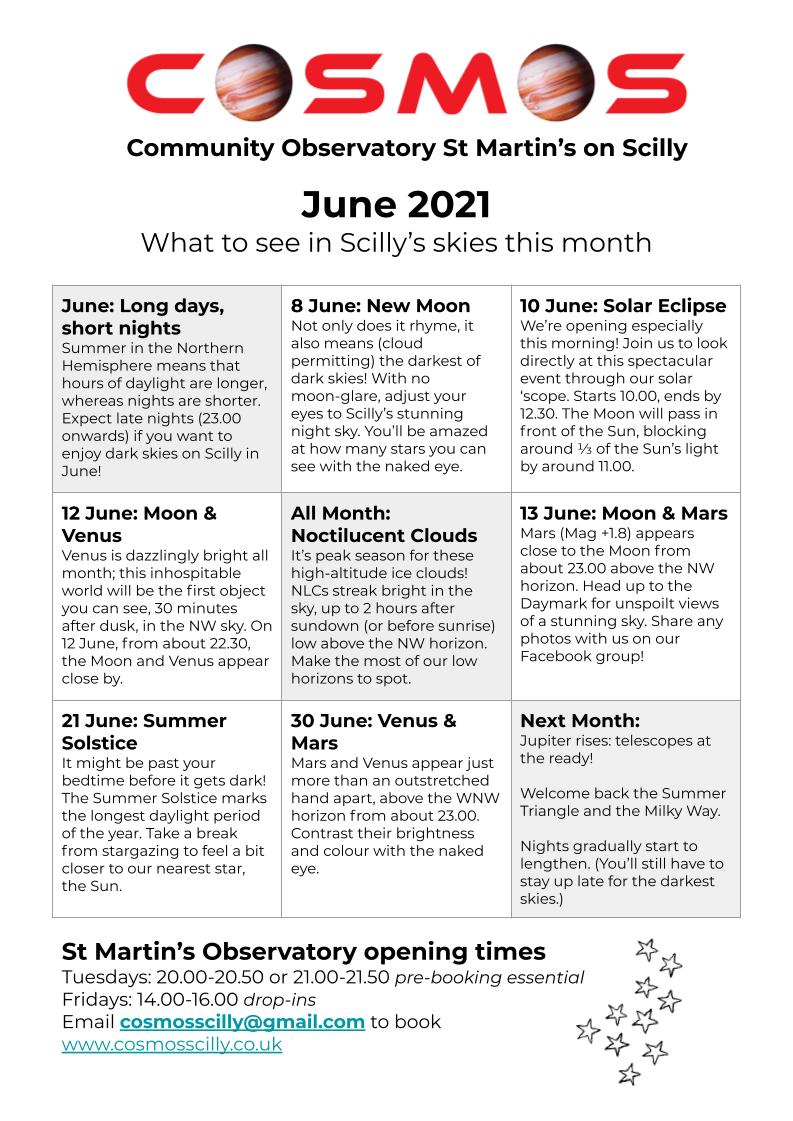|
It’s astronomy’s ‘low-season’ in June and July, as the longer hours of daylight limit truly dark skies to the wee small hours.
While it may not get completely dark while you are awake, make the most of clear nights. Just after sunset is one of my favourite times to ‘look up’, as you notice the first, brightest stars pop out, as the night sky starts to awaken. It’s also the right time of year to spot noctilucent clouds – these high-altitude clouds can appear dazzlingly bright, electric blue in the sky, up to 2 hours after sundown (or before sunrise) and above the northwest horizon. We’re very well placed for the opportunity to see NLCs on Scilly, with such low, open horizons and zero light pollution. Venus is bright all month, also above the northwest horizon, from about half an hour after sundown. It’s hard to miss at magnitude -3.8. Though it might seem odd, the lower the number, the brighter the object. So -3.8 Venus appears significantly brighter than Mars, at magnitude +1.8 from the middle of June. You can see our solar system’s planets because they reflect light, not emit it: the light you see is technically the Sun’s. There’s a good opportunity to compare the difference in planetary magnitude on 30 June, after 11pm, as Mars and Venus can be seen close together (approximately an outstretched palm apart) above the west-northwest horizon. With all this northwesterly sky action, it would be a good opportunity to head up to St Martin’s Daymark with a blanket and a flask of something! Scilly Dark Skies Week, 2-9 October 2021 We’ve announced the line-up for our Scilly Dark Skies Week 2021. Originally planned for 2020 but postponed due to the COVID-19 pandemic, we’re delighted to be going ahead on St Martin’s this year with the same speakers. We are thrilled to welcome internationally renowned astrophotographer Damian Peach, who has appeared on the BBC and the Discovery Channel. Peach's work has been used by NASA and the ESA to illustrate what ground-based telescopes can achieve in photographing the planets. Damian will lead a session on high-resolution astrophotography, sharing some of his many images, produced from the world’s largest telescopes. We’re also joined by Cornwall-based astronomer Carolyn Kennett who will be exploring the fascinating realm of astro-archaeology, the ancient connections between Scilly’s land and sky; Scilly Walks’ Katharine Sawyer will lead us on a walk to explore some of St Martins’ ancient sites with possible connections to the heavens. We couldn’t do Dark Skies Week without COSMOS regulars Ian Morison, now in his 54th year at the University of Manchester’s Jodrell Bank Observatory, and Mark Holmes of High Legh Community Observatory, who is ultimately to thank for helping us get our observatory plans off the ground! Tickets are £175 for the week, which includes daily workshops and nightly talks, plus guided stargazing. As ever, get in touch at [email protected] if you have any questions about visiting us or the night sky in Scilly.
0 Comments
Here's what we're looking at this month. Click to download this as a PDF.
|
BYCharlie Payne POSTS
September 2024
|


 RSS Feed
RSS Feed